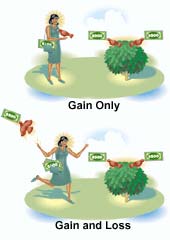| |
Real-World Decision Making
Economic models work well when applied to markets and other institutions, in part because people gathered together in large numbers seem to behave as "rational" decision makers. But individual behaviors, and the behavior of small groups of individuals like the bidders in the FCC auctions, often seem inconsistent with rationality. NSF's Decision, Risk, and Management Science Program, within the Directorate for Social, Behavioral, and Economic Sciences, supports leading scholars in the decision sciences who look at these inconsistencies from another point of view.  They try to determine the nature and origins of systematic errors in individual decision making, and use game theory to provide sets of strategies for anticipating and dealing with them. They try to determine the nature and origins of systematic errors in individual decision making, and use game theory to provide sets of strategies for anticipating and dealing with them.
Systematic errors abound in decisions that involve probability. Most people are not good at estimating the statistical likelihood of events, and their mistakes fall into distinct patterns. Reporting on these tendencies, Paul Slovic, Baruch Fischhoff, and Sarah Lichtenstein of Decision Research in Eugene, Oregon, wrote:
"People greatly overestimate the frequency of deaths from such dramatic, sensational causes as accidents, homicides, cancer, botulism, and tornadoes, and underestimate the frequency of death from unspectacular causes that claim one victim at a time and are common in nonfatal form—diabetes, stroke, tuberculosis, asthma, and emphysema…. The errors of estimation we found seemed to reflect the working of a mental shortcut or 'heuristic' that people commonly use when they judge the likelihood of risky events."
The authors explain that people judge an event as likely or frequent if instances of it are easy to imagine or recall. On the other hand, individuals often don't bother to consider information that is unavailable or incomplete. Every time we make decisions that involve probabilities, we confirm the reality of the phrase "out of sight, out of mind."
Another area where humans are systematically error-prone involves what economists call utility. We frequently face choices between doing the safe thing and taking a risk. One example is the choice between driving to work on secondary roads or taking the interstate, which usually saves several minutes but can occasionally take an extra half-hour or more because of back-ups. Another is the decision between investing in a safe money market account and taking a flier on a volatile stock.
No two people feel exactly the same about which risks are worth taking. The concept of utility combines several factors in decision making: the range of possible outcomes for a particular choice, the probability associated with each outcome, and an individual's subjective method of ranking the choices.
Imagine choosing between two tempting opportunities. One is a coin toss—heads you win $1,000, tails you win nothing. The other is a sure thing—an envelope with $500 inside. Do you choose the safe and sure $500 or the 50/50 chance to win $1,000? An economically rational person makes the choice that reflects the highest personal utility. The wealthier that individual is, for instance, and the more he or she likes to gamble, the higher is the utility of the risky 50/50 choice versus the sure thing.
|
|
